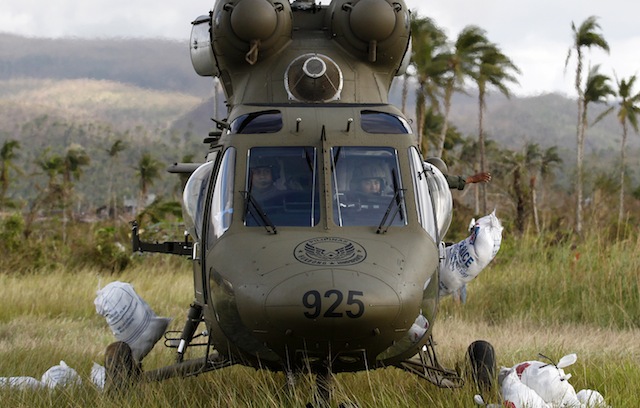SUMMARY
This is AI generated summarization, which may have errors. For context, always refer to the full article.

HOMONHON, Philippines – Helicopters dropped emergency supplies to desperate villagers as a growing global relief effort following the Philippines typhoon pushed beyond devastated towns and cities Monday towards remote island and mountain communities.
On the tiny island of Homonhon, which suffered a direct hit from Super Typhoon Yolanda (Haiyan), residents of what was left of their shattered village waited patiently as US troops unloaded water supplies from a helicopter that flew in off the USS George Washington aircraft carrier.
The approach to the village offered an aerial view of the destruction visited on the island, where thick coconut groves had been torn up and flattened.
The helicopter stayed just 10 minutes before flying off with promises to return with rice supplies.
The USS George Washington has galvanized the huge international relief effort in the central Philippines, since its arrival in the region on Thursday, November 14.
Its main task has been airlifting large-volume supplies to inland airstrips and then ferrying them piecemeal by helicopter to more remote areas.
In many villages, there is no space to land, and the helicopters are forced to hover low and drop the cartons to residents straining to remain standing against the downdraft from the rotor blades.
Television footage has shown residents of one isolated settlement jostling each other as supplies were pushed from the chopper, setting off a frenzied scramble as villagers tore apart the packing and scurried away with the contents.
Improving, but still critical
Ten days after the super storm hit the central islands of Leyte and Samar with some of the strongest winds ever recorded, aid agencies and humanitarian groups have firmly established operational posts in the flattened region’s largest city Tacloban.
There is still no regular power in Tacloban, where the typhoon triggered a powerful, tsunami-like storm surge that left thousands dead and tens of thousands homeless.
But aid distribution centers have been set up, ensuring a steady flow of food and water supplies to still-traumatized residents, while mobile surgical units are providing emergency care for the sick and injured.
Some petrol stations are open and enterprising individuals were selling fuel in Coke bottles by the side of the roads that have been largely cleared of debris, as cars and motorbikes made a tentative return to the streets.
Fresh fruit is available for a price, with makeshift stalls selling satsumas, apples and bananas.
But the overall situation remains critical, with the United Nations estimating that up to four million people have been displaced, of which only 350,000 have found shelter in evacuation centers.
The official death toll stands at 3,976 with 1,598 people missing.
The UN said an estimated 2.5 million people are in need of food assistance, and that priority should be given to ensuring supplies of rice seed for the crucial December-January planting season.
‘Patience’
The International Committee of the Red Cross (ICRC) said it had started distributing aid to residents of Guiuan, Mercedes and Salcedo – shoreline communities in southeastern Samar that were laid to waste by Super Typhoon Yolanda.
“This is only the start,” said Pascal Mauchle, head of the ICRC delegation in the Philippines. “Our next plan is to reach people in Homonhon and Suluan – small isolated islands near Guiuan – by boat.”
President Benigno Aquino III, who has come in for some criticism over the speed of the initial response to the disaster, toured the worst-hit areas on Sunday, November 17, and said he would stay in the region to oversee the relief operation.
Stressing the logistical challenge of accessing so many badly affected people spread out over such an enormous area, Aquino appealed for “patience” and vowed to accelerate the distribution where possible.
Emy Esperas Edanol, a 44-year-old fruit seller, welcomed the president’s decision to make his temporary base in the area.
“I hope that his presence here will speed up the relief,” Edanol said, as she made her way to Tacloban city hall to ask for a death certificate for her father, who was killed in the storm surge.
Although the situation in Tacloban has markedly improved in the past three days, daily life is still a grinding struggle among the grim ruins of the once thriving coastal city.
An Agence France-Presse journalist saw one man salvaging wood to rebuild his shack as three bloated bodies – two of them children – lay nearby.
“Please can you tell the authorities to come and pick these up?” he begged. – Rappler.com
Add a comment
How does this make you feel?
![[ANALYSIS] A new advocacy in race to financial literacy](https://www.rappler.com/tachyon/2024/04/advocacy-race-financial-literacy-April-19-2024.jpg?resize=257%2C257&crop_strategy=attention)


![[In This Economy] Can the PH become an upper-middle income country within this lifetime?](https://www.rappler.com/tachyon/2024/04/tl-ph-upper-income-country-04052024.jpg?resize=257%2C257&crop=295px%2C0px%2C720px%2C720px)

There are no comments yet. Add your comment to start the conversation.